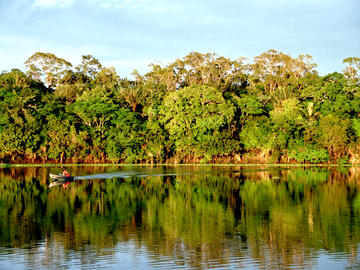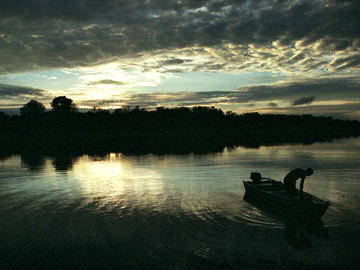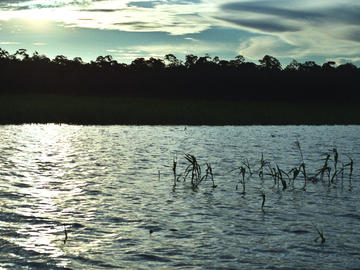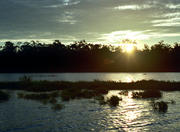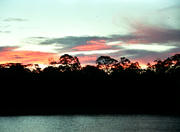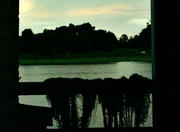Silves Island Picture 5
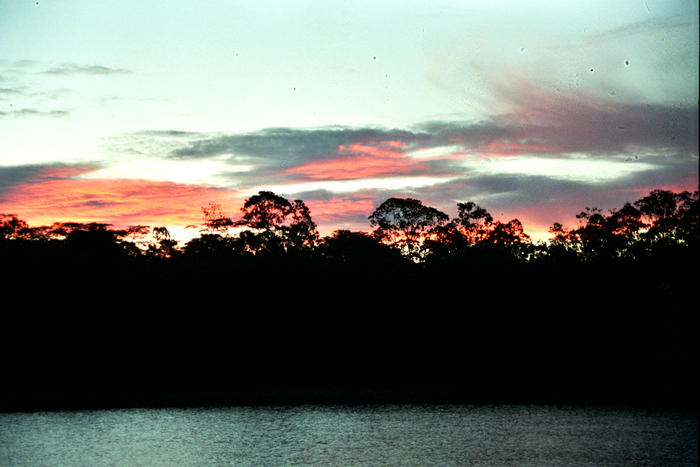
More information on Silves Island in the Amazon region Photo by: Andre Deak
Silves Island in the Amazon region
Ilha de Silves. Located 250 km from Manaus, Silves is bounded by Lake Canaçari, formed by five tributaries of the Amazon River: Urubu, Itabani Rio, Rio Sanabani, Acu affluent and affluent Ponta Grossa. It is a lowland region, the name used locally to designate the area to the river banks which is inundated during the flood season (January to June). During the dry season (July to December) the waters recede and the beaches appear. The municipality of Silves is one of the oldest in the Amazon, originating in a Indian mission founded in 1663. The 32 coastal communities are dependent on fishing, which is threatened by excessive extraction of fish in inland lakes and the expansion of livestock in the fields of the floodplain.
The communities were organized in the ASPAC (Silves Association for Environmental and Cultural Preservation) and, with support from WWF, ecotourism has become an activity for the region. Part of the proceeds from the activity is applied to ensure fish stocks for the whole year for the local population. Environmental conservation is based on the planning and use (zoning) of lakes in the county, establishing different categories of use: Preserved Lakes - Sanctuary Lakes with full protection, to allow, without interference, the natural fish breeding and restocking; Lakes Maintenance - Lagos where it is permitted only subsistence fishing for food security and local communities; Lakes Exploration and Fisheries - The rest of the regional water bodies (rivers, streams and lakes), where commercial fishing is permitted, with some restrictions regulated by federal, state and city. The monitoring is done by communities, their local association and IBAMA.
Arriving in Silves after an overnight in Manaus, take a bus to Itacoatiara. That takes 4 hours. Arriving in Itacoatiara, take the express boat, an hour and half to Silves. The city is relatively small and the Village of Lagos is one of the ends of the island, high on a hill. The Village Inn Lakes was built in 1992 and has become a central building where the reception, kitchen and restaurant and is also used for the gathering of tourists. Despite the simple construction, it's very clean and equipped with mini-bar, air conditioning and private bathroom.
Enliven (Green Life Association of Amazonia) is an association of women of the community to generate income, produce cosmetics, soaps, scented candles, jewelry and sachets with natural products of the region. The small factory is near the inn and the products are sold in a small shop downtown. The main essences are Brazilian rosewood, tonka bean and precious.
Permaculture is an agricultural activity that aims at managing natural resources, aiming to implement sustainable production systems, using new techniques of cultivation and production, seeking a better quality of life of communities. The word permaculture is the result of a coalition between the simple words: Agriculture & Permanent. It was developed as a necessary transformation: changing the current conventional production models (including the cutting and burning) for integrated production systems, thus preserving our natural systems. You can visit the ecosystem of the flooded forest and floating shelter. This is a wooden house floating on a metal platform, where members take turns, ensuring security and preservation of the lake.
There's also a beautiful region with enormous water lilies, where you'll pass through the community of St. John and can visit a flour mill in operation. The flour mill is where the Indian prepares the main source of food for his family: the cassava flour and tapioca. The entire process is done by hand where cassava is peeled, crushed, squeezed and finally toasted in large pots on the fire. Along the way, you may see plenty of herons.
Darkel is an excellent place where many foreigners love to spend the night and eat delicacies prepared by the family. You'll also pass the community of Santa Lucia, then on to massapé, where you'll see a stretch of trail in the forest. Next is a lake where the plants, including water lily, water hyacinth and aquatic fern ambe provided a wonderful landscape. There is also plenty of fruit: marimari, catauari, Abiurana, acara-caiman. Rarely addressed in articles about the Amazon, is that fish feed on these fruits, seeds, stems, etc., throughout the year. Depending on what it eats, the flavor of their meat changes. From Silves you can take a speedboat to Itapiranga. The ride was extremely enjoyable, because it's only on the lake. Next up on the tour is Itacoatiara, then back to Manaus.
Services:
Pousada Aldeia dos Lagos (92) 528-2124 aldeiadoslagos@terra.com.br
Tips: There are many insects, especially during the winter. It is recommended by the Health Department be vaccinated against yellow fever at least 10 days before travel. http://ecoviagem.uol.com.br/blogs/ecofotos/boletins/silves-comunidade-sustentavel-na-amazonia-6155.asp
More Photos of Silves Island Picture 5
